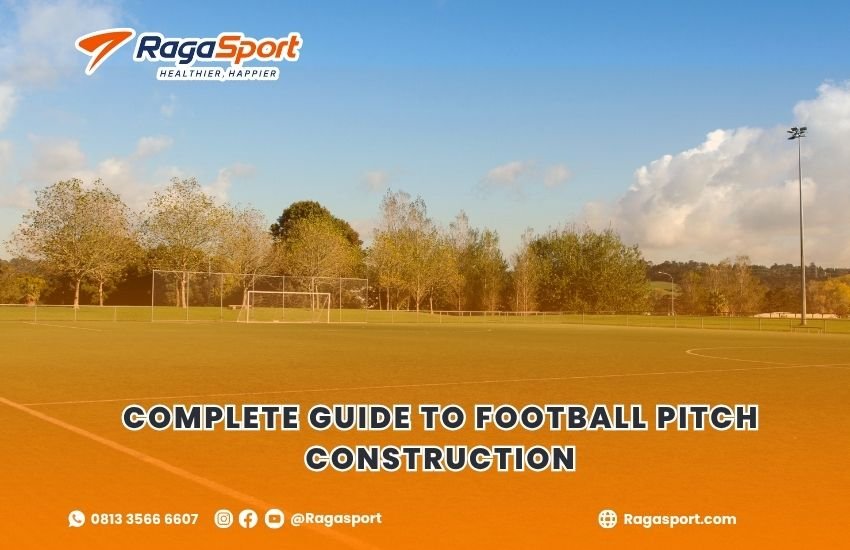Constructing a football pitch involves far more than laying grass or artificial turf. A properly built football pitch must support player safety, match regulations, weather resistance, and long-term performance. Whether for a school, training facility, club, or stadium, understanding the construction process is essential for achieving quality results. This complete guide to football pitch construction outlines each stage involved in creating a professional-grade playing surface.
Table of Contents
1. Initial Planning and Site Evaluation
a. Location and Orientation
Choosing the right location is crucial. Ideally, the pitch should be positioned north to south to minimize sun glare during play. Adequate access for construction vehicles, spectators, and future maintenance is also vital.
b. Site Survey and Soil Testing
A geotechnical survey identifies soil type, stability, and drainage properties. Based on the findings, engineers determine the best base layer and whether additional soil improvement is needed.
c. Regulatory Compliance and Permits
Builders must ensure the project complies with local regulations, environmental guidelines, and football federation requirements. This includes obtaining construction permits and zoning approvals.
2. Football Pitch Dimensions and Layout
Standard dimensions, as recommended by FIFA, are:
- Length: 100–110 meters
- Width: 64–75 meters
Exact dimensions depend on the level of competition and available space. Markings must include center circle, penalty areas, goal boxes, and corner arcs, all painted with precision.
3. Earthworks and Sub-Base Preparation
a. Excavation
The topsoil is removed and the area is graded to the desired pitch level, ensuring the correct slope for water runoff (typically 1%–1.5% sideways gradient).
b. Sub-Base Layer
A compacted layer of crushed stone or gravel is installed to support the surface and ensure stability. For natural grass pitches, this layer helps with root anchoring; for synthetic turf, it supports the shock pad and infill.
4. Drainage System Installation
Effective drainage is essential to prevent waterlogging, especially in high rainfall areas.
- Lateral drains (spaced every 5–10 meters) collect water
- Main collector drains transport it off-site
- Perforated piping is used, laid in trenches with filter gravel
The entire system is designed to keep the surface playable year-round and reduce turf damage.
5. Selecting the Playing Surface
a. Natural Grass
Best for professional clubs and traditional football aesthetics. Requires regular maintenance, irrigation, mowing, and seasonal re-turfing.
Pros:
- Preferred by many players
- Cooler surface temperature
Cons:
- High maintenance cost
- Downtime during turf recovery
b. Artificial Turf (Synthetic Grass)
Suitable for schools, recreational centers, and multi-use pitches. Offers consistent play and requires less maintenance.
Pros:
- Durable and weather-resistant
- Lower long-term upkeep
Cons:
- Higher initial cost
- Slightly increased surface temperature
6. Installation of the Surface
a. For Natural Grass
- Laying high-quality turf or seeding
- Installing irrigation and sprinkler systems
- Fertilization and mowing during establishment
b. For Synthetic Turf
- Installing shock pad (optional but recommended)
- Rolling out synthetic turf and securing seams
- Spreading infill material (sand, rubber granules) evenly
- Brushing to ensure uniform playing field
Professional installation ensures the pitch is level, safe, and ready for matches.
7. Football Equipment and Field Fixtures

Key installations include:
- Goalposts and nets (anchored securely)
- Corner flags
- Team benches and technical areas
- Scoreboards and fencing (optional)
- Lighting system for night play
LED floodlights (200–500 lux) are typically used for training, while matches may require 800–1200 lux, depending on the competition level.
8. Optional Additions for Enhanced Functionality
a. Perimeter Fencing
Helps with crowd control and protects the pitch from unauthorized use.
b. Seating and Stands
Permanent or modular stands can be installed depending on expected audience size.
c. Changing Rooms and Amenities
For tournament-level facilities, dressing rooms, showers, and media areas add professional value.
9. Maintenance Plan After Construction
Maintenance is key to prolonging pitch lifespan.
For Natural Grass:
- Regular mowing and watering
- Aeration and fertilization
- Pest and weed control
- Re-seeding bare areas
For Synthetic Turf:
- Brushing and grooming to prevent flattening
- Infill top-up
- Removing debris
- Sanitization to avoid bacteria build-up
A reputable builder will also offer a maintenance package tailored to your surface type.
10. Estimated Cost of Football Pitch Construction
The total investment depends on site conditions, surface type, and facility features:
| Pitch Type | Estimated Cost (USD) |
|---|---|
| Natural Grass Pitch | $80,000 – $150,000 |
| Artificial Turf Pitch | $150,000 – $300,000+ |
| Additional Lighting System | $25,000 – $50,000 |
| Drainage and Irrigation | $15,000 – $30,000 |
Other factors include fencing, seating, and locker rooms, which can add another $30,000–$100,000+ depending on customization.
11. Choosing the Right Football Pitch Construction Partner
To ensure a quality project, select a contractor with:
- Experience in sports infrastructure
- Knowledge of FIFA or national football standards
- Access to certified materials
- End-to-end project management capabilities
- Post-construction service and support
Working with an expert guarantees that your pitch is safe, durable, and meets player expectations.

Ready to Build the Perfect Football Pitch?
Let Raga Sport turn your vision into reality with expert construction, top-quality materials, and a field that meets every standard.
👉 Explore our projects at ragasport.com
📲 Chat with our team now via WhatsApp: Click Here

